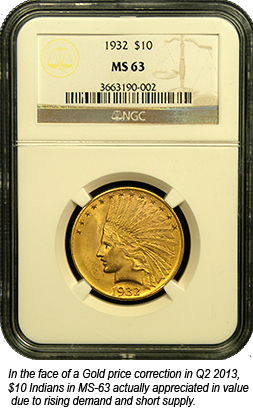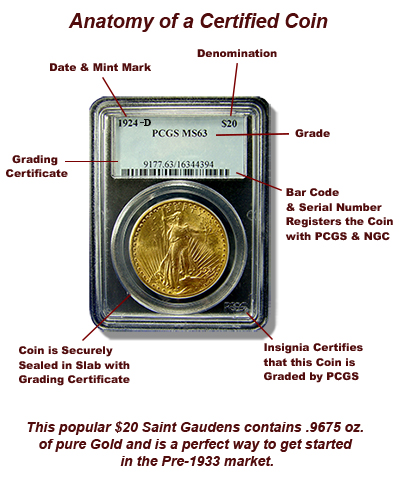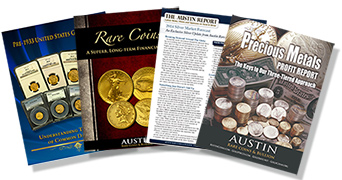Pre-1933 Investment Grade U.S. Gold
 The Benefits of Common Date Gold
The Benefits of Common Date Gold
Why You Should add Common-Date Gold to Your Modern Bullion
Like most investments, we have found that our most successful clients have assembled balanced and diversified portfolios comprised of not one, but multiple segments of the market.
Looking Beyond Bullion
We’re extremely bullish on metals long-term and confident they will provide the economic hedge, privacy, financial security, and profit center our clients seek. We agree with the projections of many analysts that gold could easily double in value as a result of unprecedented global debt. Yet, for all the pros in owning bullion, profits are anchored and limited to the percentage increase of the spot price. It offers no opportunity for leveraged gains over and above the gold move. However, there is a segment of the gold market that offers a perfect solution: Common-Date Pre-1933 U.S. Gold Coins.
“I Don’t Want To Collect Rare Coins”
To be clear, we’re not discussing rare-date coins, but instead their common-date counterparts. The difference between these two sub-segments of the Pre-1933 U.S. Gold Market is self-explanatory.
Both include coins from the same era with the same designs. The difference is that coins from certain years or mint marks are very scarce, hence the name “Rare-Dates”. Conversely, there are also those issues that have a far greater number of known survivors, either from a high mintage or survival rate, thus “Common-Dates”.
With price ranges typically between $600 up to $2,500 per coin, this market offers an excellent bridge between gold bullion and truly rare coins.
If you believe that current prices offer a fantastic opportunity to start or add to your positions, then you should strongly consider this area of the market. Certified Pre-1933 U.S. Gold offers rarity, a high gold content and appears to be oversold at today’s levels when compared to prices during the past several years.
While we don’t advise focusing solely on common-date material, the fact is they often add leverage in a rising gold market and the possibility to gain even when gold is falling. This is an important point to understand when building a balanced and diversified metals portfolio. The key is working with a knowledgeable firm who understands and realizes the best opportunities, and when to take advantage of them.
Unique Advantages of Pre-1933 Gold Coins
Best Buys in Pre-1933 Gold Coins Here
The Key to Leveraging Your Holdings
The main reason we recommend this segment of the market is due to the fixed and limited supplies as well as the understanding that no more will ever be produced. Therefore, as more investors and collectors enter the precious metals market, it stands to reason that some will eventually move into Pre-1933 gold coins.
Where Did All the Coins Go?
Beginning in the 1790’s, our ancestors used gold and silver coins for currency. As the coins circulated throughout the economy, most were worn down (much like today’s pocket change). At that time, they could have been melted down and made into new coins by the U.S. Mint or melted down for bullion bars.
At the height of the Great Depression in 1933, the U.S. Government ceased minting gold as currency and recalled all outstanding coins held by citizens. Sadly, most were melted down into bars to pay foreign debts. As a result, the supplies of these items, particularly those in uncirculated condition, were decimated. Therefore, every coin we handle today somehow managed to escape the great gold confiscation of 1933.
Coin College 101
Basic knowledge to help you gain a greater understanding of the market:
• Denomination: Common-Date gold coins are available in the four main denominations: $20, $10, $5, $2.5 with gold content from about an ounce to an eighth of an ounce.
• Design Type: 1907 is the key year separating the two major design types in U.S. Coinage. Prior to 1907, the Liberty head design was employed on all four denominations. In 1907, the switch was made to the $20 St. Gaudens, featuring the famous Walking Lady Liberty, and the $10, $5, and $2.5 Indians with Native American motifs.
• Independent Grading Services: PCGS and NGC set the standard for the authentication and grading of Pre-1933 U.S. coins. These third-party firms assign a “grade” to each coin designating its state of preservation, with a 70 being a perfect coin. For this report, it’s important to know that any coin grading Mint State (MS)-60 and higher is in uncirculated condition. Furthermore, we only recommend common-date gold coins in the investment grade range from MS-62 to MS-66 for the best value and upside potential.
• Packaging: All PCGS and NGC graded coins are sonically sealed in plastic “slabs”. The slabs are tamper-proof. The only way to remove one is by cracking it open. (See Anatomy of a Certified Coin, above).
• Certificate of Grading and Authenticity: The “cert” is sealed in the slab above the coin and displays all of its biographical information – what year and at which mint it was made, denomination, type, grade, plus a bar code that registers it with the grading service.
The grading services, grading scale, slab, and certificates are all critical components of the system developed nearly 30 years ago that helped standardize the Pre-1933 U.S. gold coin market.
With a universal process and standards in place, these coins are extremely liquid and heavily traded each day across the industry. This system has created a healthy exchange market that is liquid, transparent, and reliable. We’re constantly evaluating the common-date gold market and our top recommendations are based on the most attractive values and long-term potential.
Excellent Fundamentals
To summarize, here are the main reasons you should consider common-date gold:
• Diversification: A critical strategy for most investors, it makes good sense to spread your exposure across market segments to reduce risks and increase the strength of your portfolio as well as potential for profits. Find out more about Diversification Here.
• Fixed and Limited Supply: Because no more will be produced, common-date gold can rise in value quickly when demand overwhelms supply.
• Twice the Demand: Pre-1933 U.S. gold coins are in demand by both collectors and investors with new buyers from both categories consistently entering the market.
• A Younger Bull Market: As in the past, the modern bullion market is leading all metals segments in this long-term bull trend with many successful years ahead. common-date gold is riding the same bull wave, but we’re convinced it’s at a younger stage in the cycle behind bullion, thus our conviction that our top recommendations are excellent opportunities for diversification and profit. The way we see it, this segment offers a way to “buy gold at yesterday’s prices” and profit as the gap closes in the future.
• Solid Value at Current Levels: No one is certain what the future holds, but, as with stocks, a critical strategy in acquiring common-date gold is value. We only recommend coins that we’re convinced offer not only excellent long-term upside potential to their previous all-time highs, but also look undervalued in today’s changing marketplace.
Safety from Confiscation
It’s impossible to say how likely such action is or exactly how it would be executed. However, we believe that Pre-1933 U.S. gold coins have the best chance of being exempt from confiscation due to their track record of such status and the fact that they’re valued above their gold content. Therefore, Pre-1933 U.S. gold adds a greater insurance policy to your bullion as well as better upside potential.
Raw (Uncertified) Pre-1933 U.S. Gold
We also recommend considering “Raw” Pre-1933 U.S. Gold Coins. These are an exception to the rule of grading and certification. Raw gold coins still display attractive eye-appeal but are typically lower quality than their investment-grade, certified counterparts. They are not certified and graded by a third-party, and often trade closer to their gold content.
This interesting mix of attributes makes raw gold an ideal sub-segment for further diversification within the Pre-1933 U.S. gold market.
• The larger coins ($20 and $10) offer similar gold content and exposure to rising gold prices as modern Gold Eagles.
• Their price-point falls between that of modern bullion and their investment-grade, certified Pre-1933 counterparts.
• Their fixed and limited supply still means better prospective profits than modern gold bullion alone.
• As Pre-1933 coins, they offer far greater safety from potential government confiscation. It’s important to take advantage of the excellent values in common-date gold before a sudden surge in demand pushes prices higher.
Need advice? Call us and we can build a portfolio to fit your goals, objectives, and comfort level. Call your Austin Gold Advisor at 1-800-928-6468.
Disclaimer: Austin Rare Coins & Bullion has prepared this information for the private use of our readers. The information is not advice, and should not be treated as such.
How to Get Started Today

Call Us at 1-800-928-6468
Let our team of Austin Advisors answer all your questions. We can guide you into the best private, non-reportable hard assets to meet your needs and budget.













